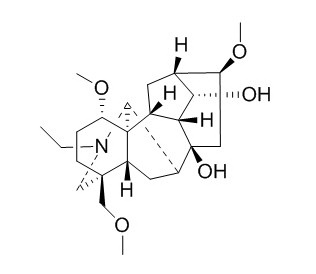Talatisamine
Talatisamine is a newly identified K+ channel blocker with hypotensive and antiarrhythmic activities. Talatisamine (120 μM) and TEA (5mM) inhibits the enhanced I(K) caused by Aβ40 oligomers, attenuates cytotoxicity of Aβ oligomers by restoring cell viability and suppressing K(+) loss related apoptotic response.
Inquire / Order:
manager@chemfaces.com
Technical Inquiries:
service@chemfaces.com
Tel:
+86-27-84237783
Fax:
+86-27-84254680
Address:
1 Building, No. 83, CheCheng Rd., Wuhan Economic and Technological Development Zone, Wuhan, Hubei 430056, PRC
Providing storage is as stated on the product vial and the vial is kept tightly sealed, the product can be stored for up to
24 months(2-8C).
Wherever possible, you should prepare and use solutions on the same day. However, if you need to make up stock solutions in advance, we recommend that you store the solution as aliquots in tightly sealed vials at -20C. Generally, these will be useable for up to two weeks. Before use, and prior to opening the vial we recommend that you allow your product to equilibrate to room temperature for at least 1 hour.
Need more advice on solubility, usage and handling? Please email to: service@chemfaces.com
The packaging of the product may have turned upside down during transportation, resulting in the natural compounds adhering to the neck or cap of the vial. take the vial out of its packaging and gently shake to let the compounds fall to the bottom of the vial. for liquid products, centrifuge at 200-500 RPM to gather the liquid at the bottom of the vial. try to avoid loss or contamination during handling.
Oxid Med Cell Longev.2021, 2021:4883398.
Antioxidants (Basel).2022, 11(12):2327.
Int J Mol Sci.2022, 23(13):7115.
Curr Issues Mol Biol.2022, 44(10):5106-5116.
Phytomedicine.2023, 116:154841.
Phytochem Anal.2013, 24(5):493-503
Buildings2023, 13(5), 1112.
J Breast Cancer.2015, 18(2):112-118
Cell Signal.2024, 124:111467.
Fitoterapia.2022, 157:105130.
Related and Featured Products
Neurosci Lett. 2012 Jun 19;518(2):122-7.
The newly identified K+ channel blocker talatisamine attenuates beta-amyloid oligomers induced neurotoxicity in cultured cortical neurons.[Pubmed:
22561032]
Loss of cytosolic K(+) through up-regulated delayed rectifier K(+) channels play an important role in beta-amyloid (Aβ) induced neurotoxicity. Potent K(+) channel blocker, particular specific for I(K) channels has been suggested as an attractive candidate for the treatment of Alzheimer's disease (AD). Talatisamine is a novel I(K) channel blocker discovered by virtual screening and electrophysiological characterization.
METHODS AND RESULTS:
In the present study, we examined the neuroprotective effect of Talatisamine against Aβ oligomers induced cytotoxicity in primarily cultured cortical neurons. The neurotoxicity related to K(+) loss caused by Aβ40 oligomers included enhanced I(K) density, increased cell membrane permeability, reduced cell viability, and impaired mitochondrial transmembrane potential. Decreased Bcl-2 and increased Bax level, activation of Caspase-3 and Caspase-9 were also observed after Aβ40 oligomers incubation. Talatisamine (120 μM) and TEA (5mM) inhibited the enhanced I(K) caused by Aβ40 oligomers, attenuated cytotoxicity of Aβ oligomers by restoring cell viability and suppressing K(+) loss related apoptotic response.
CONCLUSIONS:
Our results suggested that Talatisamine may become a leading compound as I(K) channel blocker for neuroprotection.
Neuroscience. 2008 Aug 13;155(2):469-75.
Discovery of talatisamine as a novel specific blocker for the delayed rectifier K+ channels in rat hippocampal neurons.[Pubmed:
18601983]
Blocking specific K+ channels has been proposed as a promising strategy for the treatment of neurodegenerative diseases. Using a computational virtual screening approach and electrophysiological testing, we found four Aconitum alkaloids are potent blockers of the delayed rectifier K+ channel in rat hippocampal neurons.
METHODS AND RESULTS:
In the present study, we first tested the action of the four alkaloids on the voltage-gated K+, Na+ and Ca2+ currents in rat hippocampal neurons, and then identified that Talatisamine is a specific blocker for the delayed rectifier K+ channel. External application of Talatisamine reversibly inhibited the delayed rectifier K+ current (IK) with an IC50 value of 146.0+/-5.8 microM in a voltage-dependent manner, but exhibited very slight blocking effect on the voltage-gated Na+ and Ca2+ currents even at the high concentration of 1-3 mM. Moreover, Talatisamine exerted a significant hyperpolarizing shift of the steady-state activation, but did not influence the steady state inactivation of IK and its recovery from inactivation, suggesting that Talatisamine had no allosteric action on IK channel and was a pure blocker binding to the external pore entry of the channel.
CONCLUSIONS:
Our present study made the first discovery of potent and specific IK channel blocker from Aconitum alkaloids. It has been argued that suppressing K+ efflux by blocking IK channel may be favorable for Alzheimer's disease therapy. Talatisamine can therefore be considered as a leading compound worthy of further investigations.



